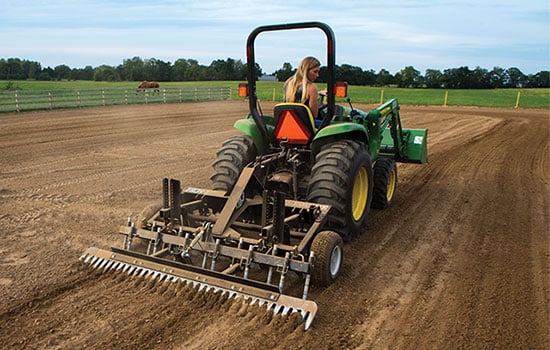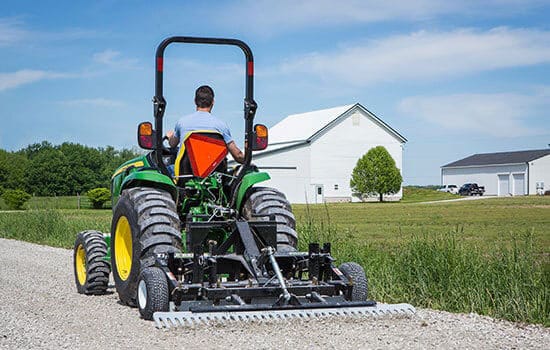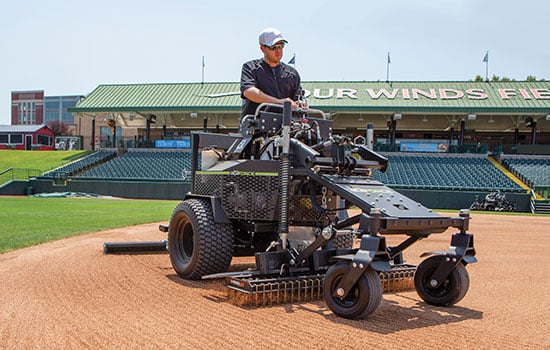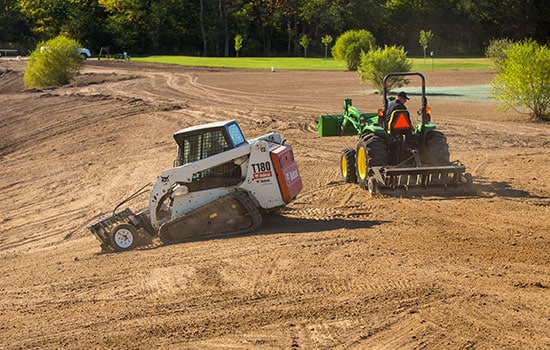On The Ground With GCI Turf Academy I ABI Dirt
ABI Products Shown In This Video
Transcript
Hi everyone, Matt Metzger here with ABI Attachments. Welcome to another round of ABI Dirt. We’ve got a really fun interview for you today, but before I introduce our guest, I want to give you a big thank you for all of your questions and comments that you’ve been leaving on our social media pages, as well as the comments below. Our hope with the ABI Dirt episodes is that we can provide you with some really helpful information on your soil projects, our products, and industry best practices. And we want to be speaking to exactly what you’re working on. So the more comments and feedback you give us, the more questions you ask, the more we’re able to help you. Now today we’ve got a really great conversation with one of our favorite grass and turf specialists. Mr. Pete Denney from GCI Turf Services in Greensboro, North Carolina. Pete is a riot, a fun guy to talk to, a fun guy to work with. And I had a chance to sit down with him a couple of days ago and talk turf and soil and root growth, so check it out. I don’t know, I’ve seen a couple of your videos and I watched you on the instructional stuff. I’ve used some of your insights when I’m working on my lawn at home. Talk me through kind of how did GCI turf services get started? I mean, how long have you been working with turf and soil?
All right, so I’ve always had a passion for working in the yard. I grew up in a farm setting.
Okay.
Go get it done, hands dirty, tractor boy. All that kind of thing. I would, I would go up to my nana’s house. She lived right up through the woods. I would go up there every single Saturday. I grew up on a tractor like that. So all this equipment stuff, that’s just, I love it, you know? I got fired from the gas company I was working for and I said, “What are we gonna do?” And I don’t know why it just popped up in my mind. I said, “Well, hey I used to mow yards.” Yeah, and that’s honestly how it started. But I basically got in my Toyota truck and I had to borrow my dad’s trailer. It’s a little tiny six-foot wide by eight-foot long. It didn’t even have ramps on the back. And then I had a string trimmer and I had a small mower and I had to borrow a buddy’s blower because I didn’t own a blower the time. And I went out and I started hustling. And I went around and said, “Hey, I’ll mow your yard for fifteen bucks. I’ll mow your yard for twenty bucks. I’ll do whatever you want me to do in your yard if you’ll pay me.”
Wow. Wow, man. That’s how GCI got started. Just hustle, straight up hustle. You’re a teacher now to so many people in the industry. And so many people are coming to you and looking at your videos to how to do something. Where did you get this? I mean, who is your, who are some of your teachers in the industry? Where did you learn this stuff?
I can humbly say that I am 99% self-taught
Wow.
It is from hours and hours of reading, hours and hours online, studying things, and more so hands-on. I’m gonna try this on this piece of ground right here, see how the grass reacts to it, and then I’m gonna take something different and I’m going to do it over here. And I’m gonna look at the difference and see what happens. And I’m a visual guy, I like to see that result. And I’ve just been doing it for fifteen years now. And it’s kinda got me to where, how I’ve managed turf.
So, Pete, I know kind of where you and ABI kind of cross paths is not so much the once the grass is growing in the spray end, and as much as like the seedbed prep and the soil prep ahead of time. And a lot of attachments we make, you know, be like the decompacting and the leveling and the finishing and get things ready to roll outside to seed. So, talk to me a little bit about seedbed prep and you in, you know, twenty years of experience, what would you say is the most common misconception out there about preparing a seedbed to plant a new lawn?
So out of thousands and thousands of customers, talking to them over the course of years, I think that the number one misconception of planting seed on the ground is you can’t plant seed on hard dirt. When I have a rock hard red clay, and I take a grass seed and I put it on top of that rock hard red clay. First of all, the seed, if it germinates, if it doesn’t wash all for slide off of that clay, if it germinates that root has to burrow through concrete, basically, and it don’t happen, it don’t work. I mean, turf grass is a good, strong plant, but most of our brands aren’t that strong. And of course you can get lucky every now and then things work out just right, but in an ideal situation, that just don’t work. So you definitely want to break that ground up, decompact it, loosen it so that the seed can actually put down in there, kind of nestled down in the ground a little bit. And then when it does germinate, it’s got loose ground under it, or looser ground than what it was. And root can start digging and start life.
Right on, oh and talk to me too, I know a lot of the tools you’ve either been on, I know that you were working with Carolina Grading and their SR-3 at one point, and you’ve got an ABI Forest. Both have a leveling component, as well as a decompacting component. Talk to me about a leveling feature and the role that a leveling component on a tool has when you’re preparing a soil for seedbed.
Well, if you come most of the yards that we mowed, even though these are, you know, $1, $2, $3 million homes, super gorgeous property, they’ll beat you to death mowing. Grading and leveling is a must in a new yard. So that through the years and years and years to come, when you’re mowing, you’re not out there, and you have to take a Tylenol every time you’ve mow, right? So the other thing would probably be for drainage issues. You know, you want your grade right for drainage because you don’t want super high spots that dry out really quickly, and you don’t want really low spots to hold water, and then you get root rot or something like that. So I think the grading, and that’s a really cool aspect of the Forest is while I’m out there doing my circles because Kevin taught me that. I used to use the grade in straight lines. And I’ve learned that the circle pattern is a much more effective way, Man this thing is also in the way I can decompact the ground, loosen it up, and move dirt all at the same time in one pass. I think it’s really cool. I’ve always had this passion for baseball. Although, who don’t like baseball? Two or three years ago, we had started doing some athletic fields. These soccer, baseball, that kind of thing. And the guy kept asking me, we were doing the turf management, the Bermuda grass management, and the guy asked me, do you know anybody can do in-field work. And every time I saw him, he’d keep asking, I was like, “Daggonit, why can’t I do your infield work?” You know, because, and that’s where, you know, a couple of Google search and all that. And then I found the Forest. And of course at that time, it was the old school. And we hooked up and got one, and since then we’ve upgraded to the Z23. we use it both for grading out infield baseball, or that kind of thing. And obviously in lawn care, it’s a two-phase machine, two-use machine. It comes in handy on both sides and like, cool, and the coolest feature is, I’m a perfectionist. I like things detailed perfect. And when the concept of laser grading can go on a machine that small, you don’t have to have this humongous thing to laser grade. I’m like, I’m sold. I’m going to own more that one of that. And so I did.
I love it. Well I love the UC division, even the way you talked about consistent decompaction, and consistent loosening. And you understand drainage and not letting root rots set in because of where your water is sitting. I mean, you understand the science behind what’s going on. And so you get the necessity of a laser, if you have those high of expectations. And some people don’t and that’s okay, that kind of goes back to the beginning of the conversation. Not everybody, you know, we’ve we see plenty of people that watch, “A chain harrow can do the same thing.” Well, a chain harrow can scratch the surface, that’s true, but getting consistent depth, and laser leveling the whole bit. Like you catch the vision, man. That’s why we love working with you, for sure.
I’ll tell you one of the coolest attachments he has is that the, I don’t know the technical name of it. The thing that cuts the line, where you cut the grass on the infield.
Oh yeah, the edger? Yep.
The edger, okay, the edger. All right, well, I got to talking to him and I was like, well, can I edge my beds with it? And he said, well sure. Why don’t you just flip the disc around-
Well, there you go.
Because you can’t put the Forest up in the bed because it cuts through the inside. So you flip the disc around, it cuts to the outside. And I did that with my yard, several other yards. And then I made a little short video clip and put it on Facebook of me doing my father-in-law’s yard.
Yeah.
About a month, it’s got a half a million views.
No way.
Yes, way. And I was like, to go in and read the comments, it was amazing that people saw the simplicity of it. It’s a disc. It does such a good job because of the spring tension and the wheel on the offset to keep the pressure right. And that’s a testament to Kevin, and ABI, you, and everybody else there, that, yeah, it’s a simplistic machine. Even though it looks complicated, the principle behind it is super simple, and that kind of stuff works, you know?
And that’s the kind of stuff that we, that’s the kind of mentality we try to incorporate to all the design work around here. I mean, I don’t know if you’ve ever got to meet our engineering team, but those guys are so down to earth. They both grew up on tractors, and that’s kind of requirement around here, right? And they, they understand that if it’s overly complicated, either A, people aren’t going to use it, or B, it’s going to be overly complicated, which means too many pieces it’s going to break, right? So you keep it simple, you keep the design simple, you make sure it does a great job. So yeah, you’re spot, on whether it’s the Forest or SR-3 or TR-3 or rascal or whatever ya got.
I thought that was unique, that everybody, a lot of those comments in that video, the main story or the main theme was look how simple it is.
Yeah.
That’s pretty cool.
Yep, I love it. I love it. I have to go check that out, I didn’t see. I keep an eye on your YouTube stuff. I don’t, track on Facebook as much. I’ll have to go take a look at it.
Cool.
Well, hey Pete, this has been a great conversation. My coffee is not quite done yet, but I really appreciate your time. I’m sure you’ve got plenty of work to do. Oh, he’s done. That’s that’s our hour glass, but I appreciate. I mean, seriously though, man, I know you’ve got a lot of work to do you get ten guys to keep track of a big old business and you’re making time for me for a video call. That means a lot to me, I appreciate it.
I appreciate you giving me the opportunity to talk. I think it’s pretty cool.
Pete, it was a pleasure as always. Thank you so much for taking the time for us, but also thank you for sharing so much solid information with anyone trying to take care of their turf. If you’re not familiar with Pete Denney please head over to his channel, GCI turf, check out what he does throughout his neighborhood in his community to take care of the soil. And as always, if you want to keep track of us here at ABI Dirt, hit that subscribe button so you don’t miss any future episodes. Until next time everyone. Take care.



